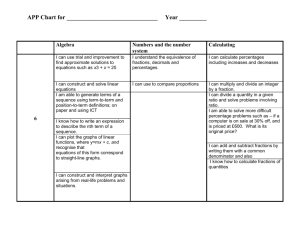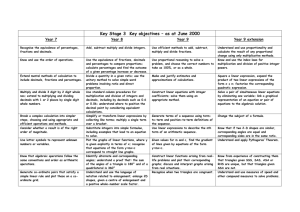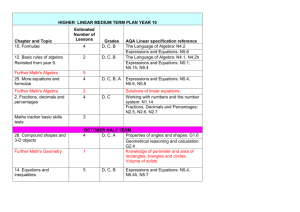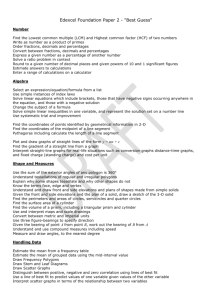Exploring maths 2 year KS3 pathways
advertisement
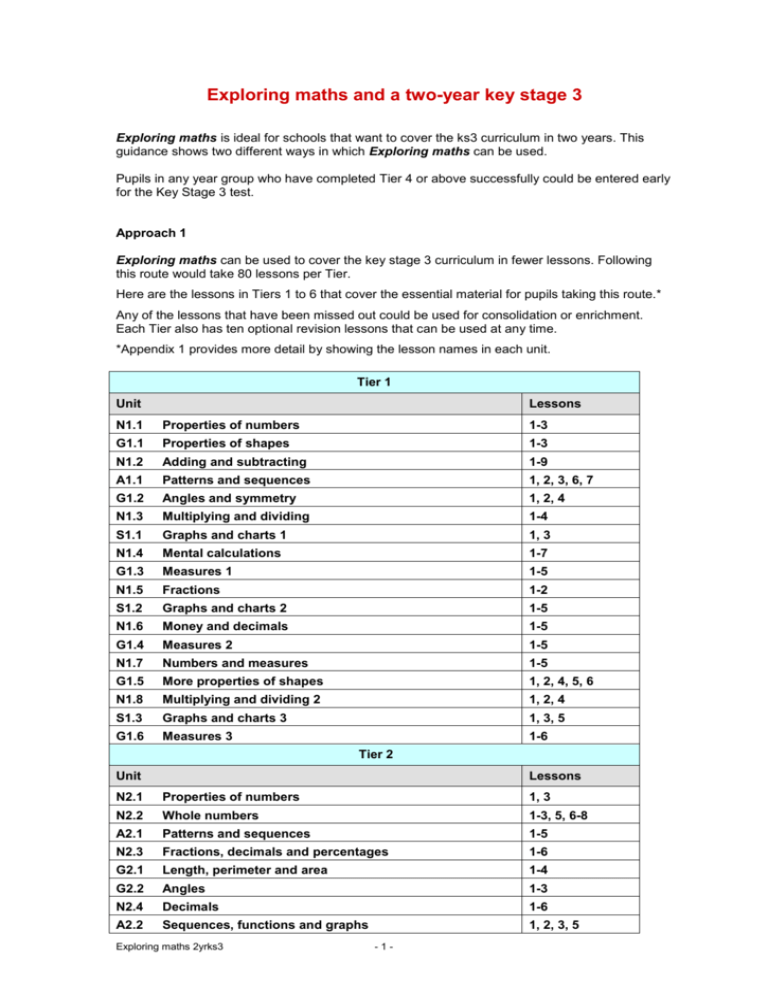
Exploring maths and a two-year key stage 3 Exploring maths is ideal for schools that want to cover the ks3 curriculum in two years. This guidance shows two different ways in which Exploring maths can be used. Pupils in any year group who have completed Tier 4 or above successfully could be entered early for the Key Stage 3 test. Approach 1 Exploring maths can be used to cover the key stage 3 curriculum in fewer lessons. Following this route would take 80 lessons per Tier. Here are the lessons in Tiers 1 to 6 that cover the essential material for pupils taking this route.* Any of the lessons that have been missed out could be used for consolidation or enrichment. Each Tier also has ten optional revision lessons that can be used at any time. *Appendix 1 provides more detail by showing the lesson names in each unit. Tier 1 Unit Lessons N1.1 Properties of numbers 1-3 G1.1 Properties of shapes 1-3 N1.2 Adding and subtracting 1-9 A1.1 Patterns and sequences 1, 2, 3, 6, 7 G1.2 Angles and symmetry 1, 2, 4 N1.3 Multiplying and dividing 1-4 S1.1 Graphs and charts 1 1, 3 N1.4 Mental calculations 1-7 G1.3 Measures 1 1-5 N1.5 Fractions 1-2 S1.2 Graphs and charts 2 1-5 N1.6 Money and decimals 1-5 G1.4 Measures 2 1-5 N1.7 Numbers and measures 1-5 G1.5 More properties of shapes 1, 2, 4, 5, 6 N1.8 Multiplying and dividing 2 1, 2, 4 S1.3 Graphs and charts 3 1, 3, 5 G1.6 Measures 3 1-6 Tier 2 Unit Lessons N2.1 Properties of numbers 1, 3 N2.2 Whole numbers 1-3, 5, 6-8 A2.1 Patterns and sequences 1-5 N2.3 Fractions, decimals and percentages 1-6 G2.1 Length, perimeter and area 1-4 G2.2 Angles 1-3 N2.4 Decimals 1-6 A2.2 Sequences, functions and graphs 1, 2, 3, 5 Exploring maths 2yrks3 -1- G2.3 Symmetry and reflection 1-3 N2.5 Decimals and measures 1-6 S2.3 Enquiry 1 1-5 G2.4 Measures 1-5 N2.6 Fractions, percentages and direct proportion 2, 3, 5, 6 S2.4 Probability 2 1, 3 G2.5 Properties of shapes 1-7 A2.3 Expressions and equations 1-5 S2.5 Enquiry 2 1-5 Tier 3 Unit Lessons N3.1 Properties of numbers 1, 2, 4, 5 A3.1 Sequences and patterns 1-5 N3.2 Whole numbers and decimals 1-5 G3.1 Area and perimeter 1-3 N3.3 Fractions and percentages 1-7 S3.1 Grouped data and simple statistics 1-3 G3.2 Angles 1-3 S3.2 Probability 1 1-3 N3.4 Decimals and measure 1-6 A3.2 Equations and formulae 1-5 S3.3 Enquiry 1 1, 2, 5 A3.3 Functions and graphs 2-5 G3.3 Transformations 1-5 N3.5 Percentages, ratio and proportion 1-4 G3.4 Properties of shapes 1, 2, 5 S3.4 Enquiry 2 1-5 G3.5 Constructions 1, 2, 3, 5, 6 A3.4 Using algebra 1-7 S3.5 Probability 2 1-3 Tier 4 Unit Lessons N4.1 Properties of numbers 1-5 G4.1 Angles and shapes 1, 2, 3, 5 A4.1 Linear sequences 1, 2, 4 N4.2 Whole numbers, decimals and fractions 1-5 S4.1 Probability 1-4 A4.2 Expressions and formulae 1, 2, 4 G4.2 Measures and mensuration 1-5 N4.3 Fractions, decimals and percentages 1-5 S4.2 Enquiry 1 1-6 A4.3 Functions and graphs 1, 3, 4, 5 N4.4 Proportional reasoning 1-4 G4.3 Transformations 1-7 A4.4 Equations and formulae 2, 3, 4, 5, 6 Exploring maths 2yrks3 -2- S4.3 Enquiry 2 1-7 G4.4 Constructions 1, 2, 3, 6, 7 A4.5 Using algebra 1-8 Tier 5 Unit Lessons N5.1 Powers and roots 1, 3 A5.1 Sequences and graphs 1, 2, 4, 5, 6 G5.1 Angles and constructions 1-8 N5.2 Proportional reasoning 1-6 S5.2 Enquiry 1 1-6 A5.2 Equations and formulae 1-6 G5.2 Measures and mensuration 1-6 N5.3 Calculations and calculators 1-6 S5.2 Probability 1 1-3 A5.3 Functions and graphs 1, 2, 4, 5, 6 G5.3 Transformations 2, 4, 6 A5.4 Using algebra 1-3 S5.3 Enquiry 2 1-7 G5.4 2D and 3D s hapes 1, 2, 4, 5, 7, 8 A5.5 Equations, formulae and graphs 1, 3, 4, 5, 6, 7 S5.4 Probability 2 1-4 Tier 6 Unit Lessons N6.1 Powers and roots 1-3 A6.1 Expressions and formulae 1-6 N6.2 Proportional reasoning 1-6 S6.1 Enquiry 1 2-6 G6.1 Geometrical reasoning 1-6 A6.2 Linear graphs and inequalities 1,3, 4, 5 G6.2 Trigonometry 1 1-3 A6.3 Algebraic expressions and equations 1, 3, 4, 5, 7 G6.3 Transformations and loci 1-6 N6.3 Decimals and accuracy 2-5 S6.2 Probability 1 1-5 G6.4 Measures and mensuration 12, 3, 4, 6 S6.3 Enquiry 2 3-7 G6.5 Trigonometry 2 1, 2, 3, 5, 6, 7, 8 A6.4 Using algebra 1-5 S6.4 Probability 2 1-4 N6.4 Using and applying maths 3-4 Exploring maths 2yrks3 -3- Approach 2 If a school has made a substantial amount of extra teaching time available across the two years, teachers can use the materials with different groups as shown below. Pupils would complete 1.5 Tiers in each year because they would be spending more time in maths lessons. ABILITY GROUP FIRST YEAR (usually Y7) SECOND YEAR (usually Y8) Lower attainers Pupils who achieved a good level 3 or weak level 4 at KS2 and will be entered for the level 4–6 test. Tier 2 (NC levels 3–4) Tier 3 (both levels 4 and 5) Tier 4 (mainly level 5) Tier 3 (both levels 4 and 5) Tier 4 (mainly level 5) Tier 5 (mainly level 6) Tier 4 (mainly level 5) Tier 5 (mainly level 6) Tier 6 (mainly level 7) Tier 5 (mainly level 6) Tier 6 (mainly level 7) Tier 7 (mainly level 8) Average attainers Pupils who achieved a secure level 4 at KS2 and will be entered for the level 5–7 test. High attainers Pupils who achieved level 5 at KS2 and will be entered for the level 6–8 test. Gifted and talented Pupils who achieved a strong level 5 at KS2 and will be entered for the level 6–8 test. Exploring maths 2yrks3 -4- Appendix 1 Exploring maths detailed two-year key stage 3 lesson pathway Tier 1 Unit Lessons N1.1 Properties of numbers 1 2 3 Multiples of 10 Multiples of 2 or 5 Odd and even numbers G1.1 Properties of shapes 1 2 3 Describing and recognising 2D shapes Describing and recognising 3D shapes Angles and lines N1.2 Adding and subtracting 1 2 3 4 5 6 7 8 9 Place value, ordering and rounding Number facts to 20 Mental strategies More mental strategies Written methods: addition Written methods: subtraction Word problems Using a calculator Number investigations A1.1 Patterns and sequences 1 2 3 6 7 Multiplication patterns Simple sequences More multiplication patterns Multiplying by 10 or 100 Multiplying bigger numbers G1.2 Angles and symmetry 1 2 4 Symmetry More symmetry Angles N1.3 Multiplying and dividing 1 2 3 4 Doubling and halving Sixes and eights Multiplication Division and remainders S1.1 Graphs and charts 1 1 3 Lists and tables Bar charts N1.4 Mental calculations 1 2 3 4 5 6 7 Quick ways to add and subtract Adding and subtracting two-digit numbers Inverse operations Introducing thousands Multiplying and dividing by 10 or 100 Working out new facts Sevens and nines G1.3 Measures 1 1 2 3 4 5 Reading time A long time What measurements to use? The metric system Measuring length N1.5 Fractions 1 2 Fractions of shapes Fractions of numbers Exploring maths 2yrks3 -5- Tier 1 cont. S1.2 Graphs and charts 2 1 2 3 4 5 Tally charts and frequency diagrams Bar charts Pictograms Carroll diagrams Venn diagrams N1.6 Money and decimals 1 2 3 4 5 Coins and notes Pounds and pence Money problems Tenths Tenths and hundredths G1.4 Measures 2 1 2 3 4 5 Clocks and timetables Seconds, minutes, hours, days and weeks Scales Mass Capacity N1.7 Numbers and measures 1 2 3 4 5 Positive and negative numbers Reading scales Adding tenths Tenths and hundredths Metres, centimetres and millimetres G1.5 More properties of shapes 1 2 4 5 6 Properties of polygons Making 2D shapes and patterns Angle Compass points Coordinates N1.8 Multiplying and dividing 2 1 2 4 Tables to 10 Multiplying by multiples of 10 Multiplication S1.3 Graphs and charts 3 1 3 5 Lists and tables Bar charts Interpreting pictograms G1.6 Measures 3 1 2 3 4 5 6 Clock, timetables and calendars Reading scales Standard metric units 1 Standard metric units 2 Perimeter Area Optional Revision units for use at any point in Tier 1 R1.1 1 2 3 4 5 Revision unit 1 Place value Adding and subtracting Money problems Properties of shapes Tables, graphs and charts Exploring maths 2yrks3 R1.2 1 2 3 4 5 -6- Revision unit 2 Sequences Multiplying and dividing Fractions Measures Charts and graphs Tier 2 Unit Lessons N2.1 Properties of numbers 1 3 Square numbers Positive and negative integers N2.2 Whole numbers 1 2 3 5 6 7 8 Place value, ordering and rounding Mental addition and subtraction Written methods Multiplying and dividing by 10, 100 and 1000 Multiplication tables Multiplication Division A2.1 Patterns and sequences 1 2 3 4 5 Continuing sequences Sequences from rules Multiples Factors Investigating patterns N2.3 Fractions, decimals and percentages 1 2 3 4 5 6 Fractions of shapes Equivalent fractions Fractions of quantities Decimal place value Tenths and hundredths Percentages of quantities G2.1 Length, perimeter and area 1 2 3 4 Length Perimeter Finding areas by counting squares Area of rectangles G2.2 Angles 1 2 3 Amounts of turn Measuring angles Drawing angles N2.4 Decimals 1 2 3 4 5 6 Decimals and the number line Ordering decimals Rounding Decimals and money Adding and subtracting decimals Using a calculator A2.2 Sequences, functions and graphs 1 2 3 5 Sequences Function machines Finding the rule Coordinates G2.3 Symmetry and reflection 1 2 3 Reflection Symmetry Translation N2.5 Decimals and measures 1 2 3 4 5 6 Metres, centimetres and millimetres Converting units of measurements Reading scales Time Remainders Word problems Exploring maths 2yrks3 -7- S2.3 Enquiry 1 1 2 3 4 5 Collecting and organising data Venn and Carroll diagrams Bar charts and pie charts Bar-line graphs Mode and range 1 2 3 4 5 Converting units Reading scales Estimating and measuring Time intervals Timetables N2.6 Fractions, percentages and direct proportion 2 3 5 6 Fractions, decimals and percentages Percentages of quantities Introducing ratio and proportion Scaling up and down S2.4 Probability 2 1 3 Probability scale Equally likely outcomes G2.5 Properties of shapes 1 2 3 4 5 6 7 Parallel and perpendicular lines Properties of shapes Classifying shapes Angles Drawing 2D shapes on grids Making shapes and solids Nets A2.3 Expressions and equations 1 2 3 4 5 Order of operations Using brackets Letters for numbers Collecting like terms Substitution S2.5 Enquiry 2 1 2 3 4 5 Collecting data Representing data Interpreting data Drawing conclusions and writing a report Line graphs G2.4 Measures Optional Revision units for use at any point in Tier 2 R2.1 Revision unit 1 1 Measures and measuring scales 2 Solving number problems 3 Sequences and patterns 4 Perimeter and area 5 Drawing and interpreting graphs and charts Exploring maths 2yrks3 R2.2 Revision unit 2 1 Inverse operations 2 Equivalent fractions, decimals and percentages 3 Expressions and equations 4 Symmetry and reflection 5 Probability -8- Tier 3 Unit Lessons N3.1 Properties of numbers 1 2 4 5 Positive and negative integers Order of operations and brackets Multiples and tests of divisibility Factors, primes, HCF and LCM A3.1 Sequences and patterns 1 2 3 4 5 Sequences and rules Find missing terms Sequences from patterns Using a letter symbol Finding a term from its position N3.2 Whole numbers and decimals 1 2 3 4 5 Place value Ordering and rounding Mental calculations Written calculations Using a calculator G3.1 Area and perimeter 1 2 3 Area and perimeter of rectangles Irregular shapes Surface area of cuboids N3.3 Fractions and percentages 1 2 3 4 6 7 Fractions of shapes Equivalent fractions Changing fractions to decimals Equivalent fractions, decimals and % Fractions of whole-number quantities Percentages of whole-number quantities S3.1 Grouped data and simple statistics 1 2 3 Constructing charts and tables Calculating statistics Interpreting graphs and diagrams G3.2 Angles 1 2 3 Measuring and drawing angles Angles on a straight line Angles at a point S3.2 Probability 1 1 2 3 The probability scale Equally likely outcomes Probability experiments N3.4 Decimals and measure 1 2 4 5 6 Estimating and converting measurements Reading scales Problems involving time Multiplication and division calculations Solving problems with a calculator Exploring maths 2yrks3 -9- A3.2 Equations and formulae 1 2 3 4 5 Terms and expressions Multiplying terms in brackets Formulae Equations: addition and subtraction Equations: multiplication and division S3.3 Enquiry 1 1 2 5 Planning a project Collecting data 1 Interpreting charts and graphs A3.3 Functions and graphs 2 3 4 5 Plotting points Straight-line graphs Plotting straight-line graphs Sequences G3.3 Transformations 1 2 3 4 5 Line symmetry Reflections Rotation symmetry Rotations Translations 1 2 Equivalent fractions and percentages Finding percentages, including discounts 3 4 Dividing a quantity in a given ratio Direct proportion N3.5 Percentages, ratio and proportion G3.4 Properties of shapes 1 2 5 Parallel and perpendicular lines Properties of shapes 1 Angle sum of a triangle S3.4 Enquiry 2 1 2 3 4 5 Collecting data Calculating statistics Using statistics Representing data Interpreting and discussing data G3.5 Constructions 1 2 3 5 6 Drawing line segments and parallel lines Constructing shapes with right angles Acute, obtuse and reflex angles Nets of 3D shapes Properties of 3D shapes A3.4 Using algebra 1 2 3 4 5 7 Working with expressions Functions and equations Solving equations Square and triangular numbers More sequences from patterns Interpreting real-life graphs 2 S3.5 Probability 2 1 2 3 Equally likely outcomes Experimental probability Comparing probabilities Exploring maths 2yrks3 - 10 - Optional Revision units for use at any point in Tier 3 R3.1 Revision unit 1 1 Whole number and decimal calculations 2 Fractions, decimals and percentages 3 Expressions and equations 4 Charts, graphs and simple statistics 5 Probability Exploring maths 2yrks3 R3.2 Revision unit 2 1 Solving word problems 2 Ratio 3 Sequences, functions and graphs 4 Area and perimeter 5 Symmetry and transformations - 11 - Tier 4 Unit Lessons N4.1 Properties of numbers 1 2 3 4 5 Order of operations Adding and subtracting directed numbers Multiplying and dividing directed numbers Powers and roots Multiples, factors and primes G4.1 Angles and shapes 1 2 3 5 Corresponding angles Alternate angles Angles in a triangle and quadrilateral Properties of quadrilaterals A4.1 Linear sequences 1 2 4 Term-to-term rules Position-to-term rules Exploring patterns N4.2 Whole numbers, decimals and fractions 1 2 3 4 5 Place value Ordering, adding and subtracting decimals Multiplication and division calculations Using a calculator Equivalent fractions and fractions of quantities S4.1 Probability 1 2 3 4 Theoretical probability Events not happening The probability of two events Experimental probability A4.2 Expressions and formulae 1 2 4 Simplifying expressions Using formulae Using algebraic expressions G4.2 Measures and mensuration 1 2 3 4 5 Conversion between units Perimeter and area of triangles Perimeter and area of quadrilaterals Volume of cuboids Surface area of cuboids N4.3 Fractions, decimals and percentages 1 2 3 4 5 Ordering fractions Calculations with fractions Multiplying and dividing decimals 1 Multiplying and dividing decimals 2 Calculating percentages S4.2 1 2 3 4 5 6 Specifying the problem and planning Processing data Representing data Analysing data sets Comparing groups Presenting results Enquiry 1 Exploring maths 2yrks3 - 12 - A4.3 Functions and graphs 1 3 4 5 Plotting points Functions, equations and graphs Sketching graphs Interpreting equations of graphs N4.4 Proportional reasoning 1 2 3 4 Dividing a quantity in a given ratio Solving ratio problems Scale drawings Direct proportion – the unitary method G4.3 Transformations 1 2 4 5 7 Repeated transformations Using transformations to solve problems Scale factor Centre of enlargement Finding the midpoint A4.4 Equations and formulae 2 3 4 5 6 Solving linear equations More linear equations Forming equations and formulae Equations with brackets Terms with x on both sides of the equation S4.3 Enquiry 2 1 2 3 4 5 6 7 Collecting continuous data Processing and representing continuous data Analysing and interpreting distributions Communicating findings Mean, median and range Comparing experimental and theoretical probability Line graphs for time series G4.4 Constructions 1 2 3 6 7 Drawing arcs and circles Constructing midpoints and bisectors Constructing triangles on paper Scale drawings Using bearings A4.5 Using algebra 1 2 3 4 5 6 7 8 Simplifying expressions Factorising expressions Solving linear equations Sketching linear graphs Drawing and interpreting linear graphs Interpreting graphs of real-life situations Word problems Geometrical problems Optional Revision units for use at any point in Tier 4 R4.1 1 2 3 4 5 Revision unit 1 Place value Solving calculations problems Expressions and sequences Perimeter, area and volume Probability Exploring maths 2yrks3 R4.2 1 2 3 4 5 - 13 - Revision unit 2 Percentages Ratio and proportion Equations and graphs Angles and transformations Representing and interpreting data Tier 5 Unit Lessons N5.1 Powers and roots 1 3 Working with integer powers of numbers Prime factor decomposition A5.1 Sequences and graphs 1 2 4 5 6 Generating sequences Making generalisations Sketching linear graphs Rearranging linear equations Graphs using real-life contexts G5.1 Angles and constructions 1 2 5 6 7 8 Angles in polygons Regular polygons Polygons and parallel lines Constructions Constructing triangles Loci N5.2 Proportional reasoning S5.2 Enquiry 1 1 2 3 4 5 6 1 2 3 4 5 6 Adding and subtracting fractions Multiplying fractions Dividing fractions Percentage change Ratio Direct proportion Stem-and-leaf diagrams Starting investigation 1 Completing investigation 1 Data collection sheets Starting investigation 2 Completing investigation 2 A5.2 Equations and formulae 1 2 3 4 5 6 Multiplying out brackets Factorising expressions Substituting into formulae Changing the subject of a formula Solving linear equations Trial and improvement G5.2 Measures and mensuration 1 Perimeter and area 2 3 Finding Area of a circle 4 5 6 Solving circle problems and using Volume of prisms Surface area of prisms 1 2 3 4 5 6 1 2 3 Powers of 10 Rounding and approximation Mental calculations with decimals Written calculations with decimals Using a calculator Problems involving measures Theoretical and experimental probability Mutually exclusive events Using experimental probability N5.3 Calculations and calculators S5.2 Probability 1 Exploring maths 2yrks3 - 14 - A5.3 Functions and graphs 1 2 4 5 6 Generating linear graphs using ICT Sketching graphs Drawing accurate graphs Direct proportion Simple quadratic graphs using ICT G5.3 Transformations 2 4 6 Combined transformations Enlargements Length, area and volume A5.4 Using algebra 1 2 3 Using graphs to solve problems Using algebra in geometry problems Using algebra in investigations S5.3 Enquiry 2 1 2 3 4 5 6 7 Calculating statistics Line graphs for time series Scatter graphs Planning and collecting data Organising and presenting data Analysing and interpreting data Reporting and evaluating G5.4 2D and 3D shapes 1 2 4 5 7 8 Exploring angles and lines Solving problems Drawing 3D objects Drawing plans and elevations Solving problems using surface area and volume Surface area and volume of prisms A5.5 Equations, formulae and graphs 1 3 4 5 6 7 Factorising Working with formulae Forming equations Visualising graphs Interpreting graphs Matching graphs to real-life situations S5.4 1 2 3 4 Simple probability Equally likely outcomes with two events Mutually exclusive events Practical probability experiments Probability 2 Optional Revision units for use at any point in Tier 5 R5.1 1 2 3 4 5 Revision unit 1 Efficient calculations Using percentages to compare proportions Sequences, equations and graphs Angles and polygons Constructing and interpreting diagrams Exploring maths 2yrks3 R5.2 1 2 3 4 5 - 15 - Revision unit 2 Ratio and proportion Solving number problems Expressions, equations and formulae Circles and enlargements Probability Tier 6 Unit Lessons N6.1 Powers and roots 1 2 3 Squares, cubes and roots Equivalent calculations using powers of 10 Standard form A6.1 Expressions and formulae 1 2 3 4 5 6 Simplifying algebraic fractions Solving linear equations Expansion of brackets Factorising Identities Changing the subject of a formula N6.2 Proportional reasoning 1 3 4 5 6 Fraction calculations Percentages and interest rates Reverse percentages Rate and speed Proportionality S6.1 Enquiry 1 2 3 4 5 6 Grouped data – frequency polygons Grouped data – average and range 1 Grouped data – average and range 2 Comparing sets of grouped data Scatter graphs and lines of best fit G6.1 Geometrical reasoning 1 2 3 4 5 6 Isosceles triangle problems Evidence or proof? Congruent triangles Radii, chords and tangents Similar shapes Introducing Pythagoras’ rule A6.2 Linear graphs and inequalities 1 3 4 5 Sketching and drawing linear graphs Properties of linear graphs Solving simultaneous equations 1 Solving simultaneous equations 2 G6.2 1 2 3 Introducing trigonometry Using tangent Using sine and cosine A6.3 Algebraic expressions and equations 1 3 4 5 7 Simultaneous equations 1 Expanding brackets 1 Expanding brackets 2 Factorising quadratic expressions Solving quadratic equations graphically G6.3 1 2 3 4 5 6 How long is that line? Divide that line Enlargement Rotation Combinations of transformations Loci 1 Trigonometry 1 Transformations and loci Exploring maths 2yrks3 - 16 - Tier 6 cont. N6.3 Decimals and accuracy 2 3 4 5 Significant figures Using a calculator Back of an envelope calculations Measurement errors S6.2 Probability 1 1 2 3 4 5 Relative frequency Exploring relative frequency Combined events Tree diagrams and independent events Probability experiments G6.4 Measures and mensuration 1 2 3 4 6 Arcs and circumference Sectors and area Right-prisms and cylinders Units of area and volume Plans and elevations S6.3 Enquiry 2 3 4 5 6 7 Drawing and interpreting frequency polygons Grouped data – estimating the mean Grouped data – average and range Scatter graphs and lines of best fit Lengths and angles 1 G6.5 Trigonometry 2 1 2 3 5 6 7 8 Using Pythagoras to find the hypotenuse Using Pythagoras’ rule to find a shorter side Triangles Using the trigonometry ratios Choosing between sine, cosine and tangent Finding lengths Tessellations A6.4 Using algebra 1 2 3 4 5 Properties of linear graphs Parallel and perpendicular lines Generating quadratic graphs Generating cubic graphs Drawing quadratic graphs S6.4 Probability 2 1 2 3 4 Ice cream sales Right or left or …? Tree diagrams and probability Relative frequency and theoretical probability N6.4 Using and applying maths 3 4 Investigating paper sizes Proof Optional Revision units for use at any point in Tier 6 R6.1 1 2 3 4 5 Revision unit 1 Fractions and percentages Ratio and proportion Expressions and equations Angles and triangles Probability Exploring maths 2yrks3 R6.2 1 2 3 4 5 - 17 - Revision unit 2 Decimals Sequences and graphs Graphs and equations 2D and 3D shapes Grouped frequency


